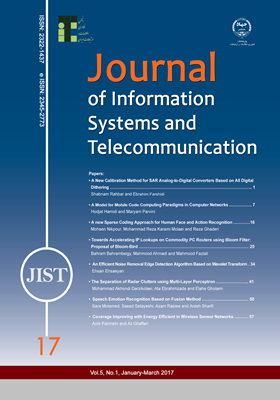-
-
List of Articles
-
Open Access Article
1 - A New Calibration Method for SAR Analog-to-Digital Converters Based on All Digital Dithering
Ebrahim Farshidi Shabnam Rahbar -
Open Access Article
2 - A Model for Mobile Code Computing Paradigms in Computer Networks
Hojatallah Hamidi Maryam Parvini -
Open Access Article
3 - A new Sparse Coding Approach for Human Face and Action Recognition
Mohsen Nikpoor Mohammad Reza Karami-Mollaei Reza Ghaderi -
Open Access Article
4 - Towards Accelerating IP Lookups on Commodity PC Routers using Bloom Filter: Proposal of Bloom-Bird
Bahram Bahrambeigy Mahmood Ahmadi mahmood Fazlali -
Open Access Article
5 - An Efficient Noise Removal Edge Detection Algorithm Based on Wavelet Transform
Ehsan Ehsaeian -
Open Access Article
6 - The Separation of Radar Clutters using Multi-Layer Perceptron
Mohammad Akhondi Darzikolaei Ataollah Ebrahimzadeh Elahe Gholami -
Open Access Article
7 - Speech Emotion Recognition Based on Fusion Method
Sara Motamed Saeed Setayeshi Azam Rabiee Arash Sharifi -
Open Access Article
8 - Coverage Improving with Energy Efficient in Wireless Sensor Networks
Amir Pakmehr Ali Ghaffari
-
The rights to this website are owned by the Raimag Press Management System.
Copyright © 2017-2025







